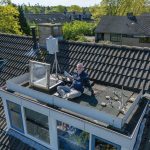
1 Introduction
CAMS Florida began operation with two cameras in 2014. It has grown to twenty-nine cameras at five sites in 2020. The cameras provide excellent coverage of northern Florida. Areas that are currently outside coverage are the panhandle (western Florida) and south Florida.
This report summarizes CAMS Florida activity during January 1 – March 31, 2020. UFOOrbit was used to generate summary data from the detection files produced each night using CAMS 2.0 software. NASA reported orbits are 5-10% higher, probably because it uses a more refined algorithm for coincidence detection.
2 Statistical Report
During the first three months (91 nights) of 2020, CAMS Florida made 13,424 observations of multi-station meteors. These observations contributed to a total of 5,226 orbits. On average, 2.6 sites contributed to each orbital determination. Following are the specific contributions by each of the five CAMS Florida sites:
- Gainesville (CAMS Florida HQ)
- cameras =10
- orbits = 4697
- orbits/camera = 470
- orbits/camera/night = 5.2
- New Smyrna Beach (BarJ Observatory)
- cameras = 2
- orbits = 918
- orbits/camera = 459
- orbits/camera/night = 5.0
- Melbourne (Florida Institute of Technology)
- cameras = 1
- orbits = 268
- orbits/camera = 268
- orbits/camera/night = 2.9
- Ocala (College of Central Florida)
- cameras = 8
- orbits = 3716
- orbits/camera = 465
- orbits/camera/night = 5.1
- Ocklawaha
- cameras = 8
- orbits = 3825
- orbits/camera = 478
- orbits/camera/night = 5.3
- TOTALS
- cameras = 29
- orbits determined = 13424
- orbits/camera = 463
- orbits/camera/night = 5.1
3 CAMS Florida Site Notes
Barbara Harris operates two cameras at her rooftop observatory near New Smyrna Beach. This system began operation in 2014, when CAMS Florida was established. At Florida Institute of Technology (Florida Tech) in Melbourne, Csaba Palotai and Ashley Hughes manage the camera that is on the roof of the Physical Sciences Building. Because Florida Tech is close to Kennedy Space Center, CAMS has an excellent view of space launches! At College of Central Florida in Ocala, physics professor Erika Kisvarsanyi oversees operation of eight cameras on the rooftop of the science building. These cameras have worked flawlessly for over one year with 100% uptime! The newest addition to CAMS Florida is operated by Jerry Cheney from the back yard of his home in Ocklawaha. The only thing that worries him are the wild hogs that get curious about CAMS equipment during mating season.
4 Radiant Plot of Meteors
The attached plot shows the radiants of all 5226 meteoroids for which orbits were determined during the first three months of 2020. About 95% of the radiants are from sporadic meteors, while the other 5% coming from known showers. The concentration of radiants (colored green) in the upper left portion is from the Quadrantids (#10, QUA). The Coma Berenicids (#20, COM) comprise a more diffuse radiant above the image’s center.
95% sporadic meteors is too high! Let’s continue our work to discern more meteor showers in the flux of interplanetary meteoroids.
5 Acknowledgments
CAMS Florida would not be possible without the following volunteers:
- Jerry Cheney (Ocklawaha, CAMS 5040-5047)
- Barbara Harris (BarJ Observatory, CAMS 231, 232)
- J. Andreas (Andy) Howell (Gainesville, CAMS 230, 234, 5000-5007)
- Ashley Hughes and Csaba Palotai (Florida Institute of Technology, CAMS 233)
- Erika Kisvarsanyi (College of Central Florida, CAMS 5020-5027)
- Dave Samuels, CAMS Operations Coordinator
Many thanks are due them for their efforts in support of the Cameras for All-Sky Meteor Surveillance (CAMS). We also thank Dr. Peter Jenniskens, principal investigator of the CAMS project.





